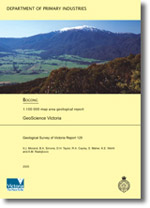GSV Report 125 - Bogong 1:100 000 map area geological report
 |
| |||||||||||||||||||||||||||||||||||||||||||||||||||||||||||||||||||||||||||||||||||||
Product description:Download The downloadable version of this report is supplied in PDF format and is a high quality but large file (215MB) and 5 associated maps (37MB). Abstract This report describes the geology of the BOGONG 1:100 000 map sheet 8324, shown on the accompanying Mitta Mitta (8324-1), Falls Creek (8324-2); Feathertop (8324-3) and Tawonga (8324-4) 1:50 000 geological maps. It contains a summary of previous work and gives a description of all rock units in the map area and a comprehensive account of the physiography, landscape evolution, geological history and structural and economic geology. BOGONG contains rocks of mainly Palaeozoic and Cainozoic age. Palaeozoic rocks lie within two structural zones of the Lachlan Fold Belt: the Tabberabbera Zone in the west and the Omeo Zone in the east, separated by the Kiewa and Kancoona shear zones. The oldest units are the Early Ordovician Pinnak Sandstone, a deep marine sequence of mainly quartzrich turbidites, and the conformably overlying Late Ordovician Bendoc Group, consisting of graphitic mudstone and thin bedded quartz wacke. The Pinnak Sandstone occupies the Tabberabbera Zone and much of the Omeo Zone in BOGONG, while the Bendoc Group is only in the Omeo Zone. In the Early Silurian the Benambran Orogeny deformed the Pinnak Sandstone and Bendoc Group, generating close to tight folds and thrust faults. Regional low-pressure/high-temperature metamorphism accompanied deformation, creating the Omeo Metamorphic Complex within the Omeo Zone, for which the Pinnak Sandstone is the protolith. The metamorphic complex occupies the central part of the map area. Metamorphic zones are cordierite, muscovite–sillimanite, andalusite–K-feldspar, sillimanite–K-feldspar and migmatite, and rock types are pelitic to psammitic schist, gneiss and migmatite. In general metamorphic grade increases gradually from northeast to southwest. The western side of the complex is marked by the Kiewa and Kancoona shear zones, which juxtapose high-grade rocks against lowgrade Pinnak Sandstone of the Tabberabbera Zone. Schistosity and gneissosity in the Omeo Metamorphic Complex are folded into several generations of folds, but the dominant foliations strike northwest to east-west and are generally concordant with the metamorphic isograds. Partial melting during metamorphism generated several S-type granites, including the widespread Cobungra Granite, the Mount Wills Granite and numerous small bodies of leucogranite and biotite granodiorite. Two small I-type plutons, the Pretty Valley and Bundara tonalites, were also probably emplaced during the Benambran Orogeny. Many dykes were emplaced in the Silurian period, including pegmatite and albitite of the Dorchap Dyke Swarm, and dolerite and diorite dykes. The main effects of the Early Devonian Bindian Orogeny were the generation of large dextral strikeslip shear zones (Kiewa, Kancoona and Nelse) and greenschist facies metamorphism of Silurian dykes. During and just after the Bindian Orogeny, numerous plutons of granite, granodiorite, tonalite and quartz diorite were emplaced, most of them magnetic Itypes. Some were deformed within shear zones (e.g. Dederang and Mount Beauty granites in the Kiewa Shear Zone and Wollonaby Granite in the Nelse Shear Zone), but most are largely undeformed. Numerous dykes of basalt, dolerite, andesite, diorite, rhyolite and porphyry were emplaced in the Early Devonian, most prominently in the Omeo Zone. They are undeformed but commonly altered. Deformation in the Middle Devonian Tabberabberan Orogeny resulted in north-striking crenulation cleavage in the Tabberabbera Zone but little discernible effect in the Omeo Zone. Similarly, the Early Carboniferous Kanimblan Orogeny has left little record in BOGONG. No definite Mesozoic rocks occur in BOGONG, but several lamprophyre dykes intruding the Omeo Zone may be of this age. This time was one of no deposition, and probably widespread erosion. Uplift of the Victorian Highlands probably began in the Cretaceous as Australia and Antarctica began to rift apart. Palaeogene rocks in BOGONG are restricted to Eocene alluvial deposits and Eocene–Oligocene alkalic basalts of the Older Volcanics. The basalts form flat-lying flows in the south of the mapsheet, unconformably overlying Palaeozoic rocks of the Tabberabbera and Omeo zones. Dykes and plugs of basalt are common in the south of the map. In the southwest corner of BOGONG are numerous dykes and pipes of phonolite, probably the same age as the Older Volcanics but possibly Mesozoic. Further uplift of the highlands in the mid-Cainozoic lifted them to their current height, facilitated by dip-slip movement on the Tawonga Fault which lifted its southeastern side about 700 m relative to the northwestern side. Incision by streams has formed several large valleys penetrating deep into the highlands, with flat floors of alluvium and aprons of colluvium on the valley sides. Pleistocene periglacial conditions gave rise to rock rivers and boulder fields above 1700 m elevation. The main economically important commodities in BOGONG are gold and tin. Gold mining, both hard rock and alluvial, has been concentrated in three gold fields: Harrietville–Wandiligong, Glen Wills and Mitta Mitta. In the Harrietville–Wandiligong goldfield, gold has been mined from quartz reefs occupying faults in the Pinnak Sandstone. Large sluicing operations have been carried out in the alluvial flats of the Ovens River. At Glen Wills, gold has been mined from reefs within pegmatite and Mount Wills Granite. These are brittle faults post-dating the high-grade regional metamorphism. Gold mining at Mitta Mitta has mainly been sluicing of Recent and older river gravels of the Mitta Mitta River and its tributaries. Minor gold has also been extracted from altered parts of the nearby Banimboola Quartz Monzodiorite. Tin-bearing pegmatite and albitite dykes west of Mitta Mitta (Dorchap Dyke Swarm) are widespread. They are also potential sources of tantalum and other rare earth elements. Bibliographic reference Morand, V.J., Simons, B.A., Taylor, D.H., Cayley, R.A., Maher, S., Wohlt, K.E. & Radojkovic, A.M., 2005. Bogong 1:100 000 map area geological report. Geological Survey of Victoria Report 125. Related products:
| ||||||||||||||||||||||||||||||||||||||||||||||||||||||||||||||||||||||||||||||||||||||







